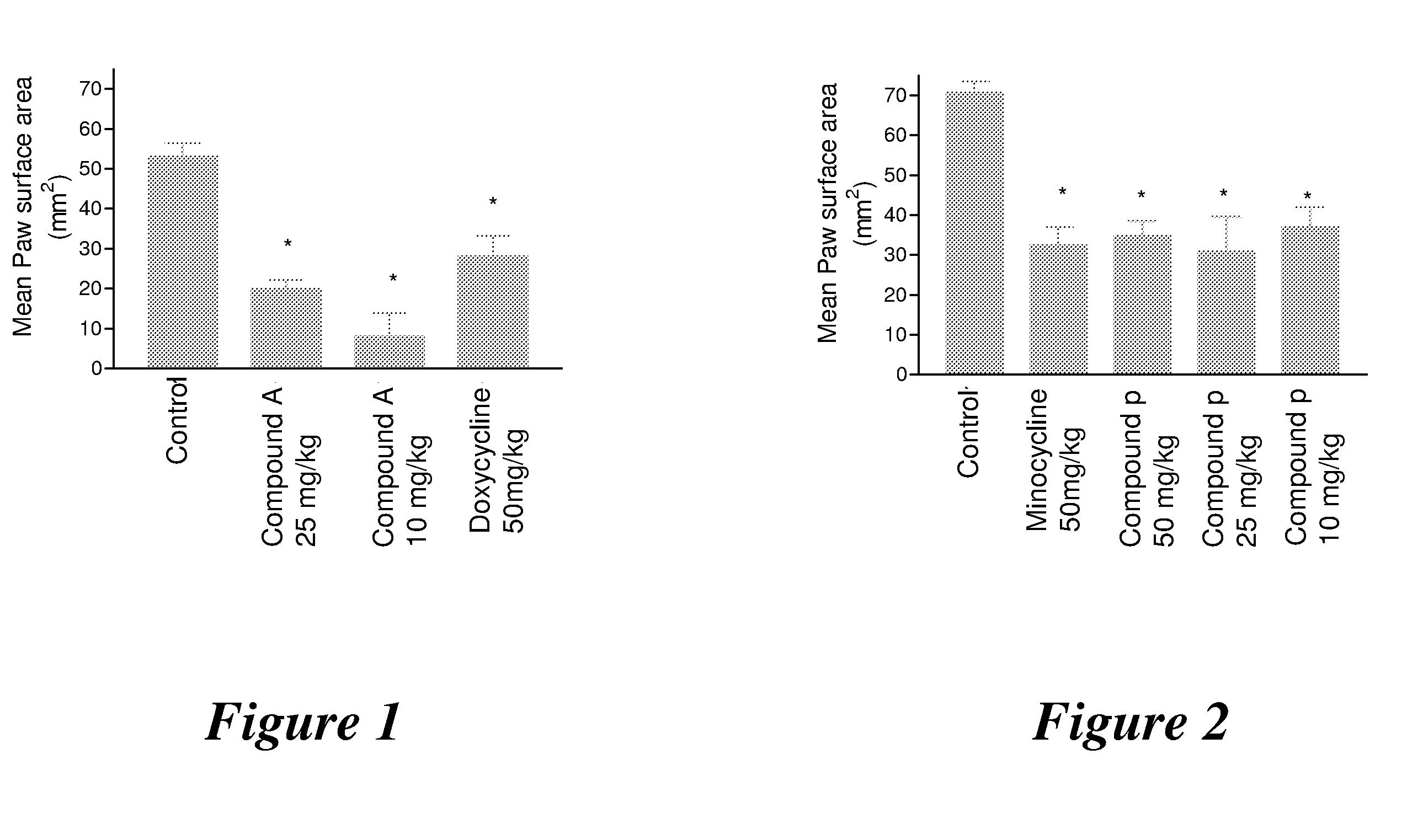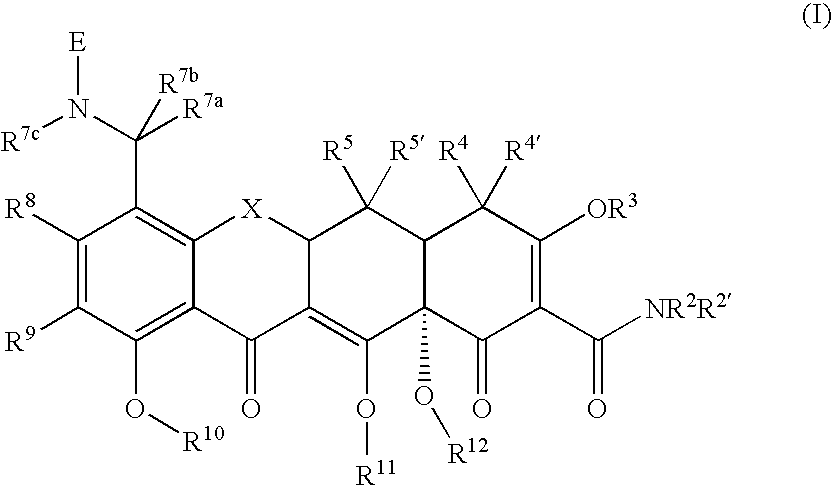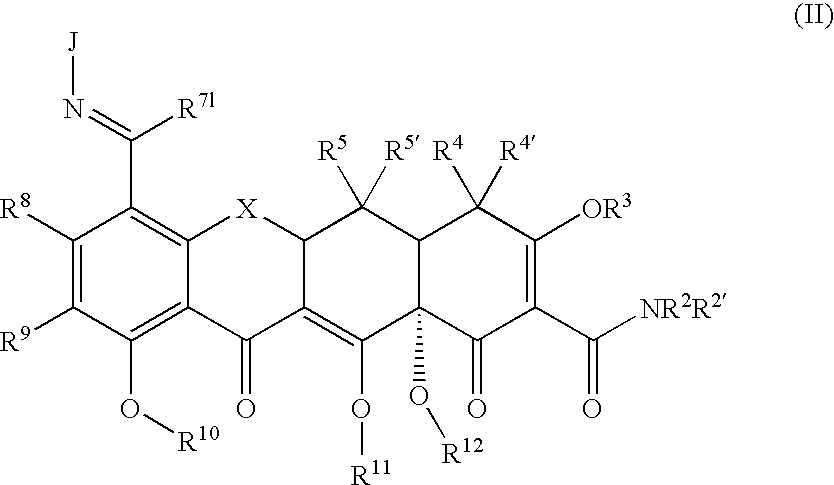Substituted Tetracycline Compounds for Treatment of Inflammatory Skin Disorders
- Summary
- Abstract
- Description
- Claims
- Application Information
AI Technical Summary
Benefits of technology
Problems solved by technology
Method used
Image
Examples
example 1
Synthesis of Selected Compounds of the Invention
(4S,4aS,5aR,12aS)-4-Dimethylamino-3,10,12,12a-tetrahydroxy-7-[(methoxy-methyl-amino)-methyl]-1,11-dioxo-1,4,4a,5,5a,6,11,12a-octahydro-naphthacene-2-carboxylic acid amide (Compound P)
[0301]
[0302]A solution of 7-formylsancycline TFA salt (2.23 g) and N,O-dimethylhydroxylamine hydrochloride (780 mg) in N,N-dimethylacetamide (15 mL) was stirred for 10 minutes at room temperature under argon atmosphere. To this solution was added sodium cyanoborohydride (302 mg). The solution was stirred for 5 minutes and monitored by LC-MS. The reaction mixture was poured into diethyl ether, and the resulting precipitates were collected by filtration under vacuum. The crude product was purified by prep-HPLC using a C18 column (linear gradient 10-40% acetonitrile in 20 mM aqueous triethanolamine, pH 7.4). The prep-HPLC fractions were collected, and the organic solvent (acetonitrile) was evaporated in vacuo. The resulting aqueous solution was loaded onto a ...
example 2
Anti-Bacterial Activity
[0351]In this example, the gram (+) and gram (−) antibacterial activities of the tetracycline compounds used in the methods of the invention were assessed.
[0352]Gram (−) and gram (+) antibacterial minimum inhibitory concentration (MIC) values (μg / mL) were obtained using CLSI methodology for anti-bacterial susceptibility testing. On each day of testing, serial dilutions of compounds were prepared in microdilution plates using a Tecan robotic workstation. Mueller Hinton broth cultures of representative sensitive and resistant gram negative strains were grown or adjusted to match the turbidity of a 0.5 McFarland standard. 1:200 dilutions were made in an appropriate broth (cation supplemented Mueller Hinton broth) to allow a final inoculum of 1×105 cfu. Plates were incubated at 35° C. in ambient air for 18-24 hours, were read spectrophotometrically and checked manually for evidence of bacterial growth. The lowest dilution of compound that inhibited growth was reco...
example 3
Toxicity Profile
[0353]In this example, the cytotoxicity of the tetracycline compounds used in the methods of the invention were assessed.
[0354]Mammalian cell cytotoxicity was assessed to evaluate potential in vivo risks associated with the tetracycline compounds of the invention. A soluble, non-toxic redox dye (“Resazurin”; Alamar Blue) was used to assess a tetracycline compound's effect on cellular metabolism. At the onset of the experiment, cultures of mammalian COS-1 or CHO cells were washed, trypsinized, and harvested. Cell suspensions were prepared, seeded into 96-well black-walled microtiter plates, and incubated overnight at 37° C., in 5% CO2 and approximately 95% humidity. On the next day, serial dilutions of test drug were prepared under sterile conditions and transferred to cell plates. Plates were then incubated under the above conditions for 24 hours. Following the incubation period, the media / drug was aspirated, and 50 μL of resazurin was added. Plates were then incubat...
PUM
| Property | Measurement | Unit |
|---|---|---|
| Density | aaaaa | aaaaa |
| Fraction | aaaaa | aaaaa |
| Dimensionless property | aaaaa | aaaaa |
Abstract
Description
Claims
Application Information
 Login to View More
Login to View More - R&D
- Intellectual Property
- Life Sciences
- Materials
- Tech Scout
- Unparalleled Data Quality
- Higher Quality Content
- 60% Fewer Hallucinations
Browse by: Latest US Patents, China's latest patents, Technical Efficacy Thesaurus, Application Domain, Technology Topic, Popular Technical Reports.
© 2025 PatSnap. All rights reserved.Legal|Privacy policy|Modern Slavery Act Transparency Statement|Sitemap|About US| Contact US: help@patsnap.com



